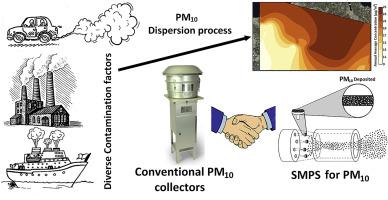Chemosphere ( IF 8.8 ) Pub Date : 2020-07-01 , DOI: 10.1016/j.chemosphere.2020.127482 Héctor Morillas 1 , Ainara Gredilla 2 , Euler Gallego-Cartagena 3 , Settakorn Upasen 4 , Maite Maguregui 5 , Juan Manuel Madariaga 6

|
Speciation of respirable particles is becoming increasingly important from an epidemiological and analytical point of view to determine the potential effects of air pollution on human health. For this reason, current laws and analytical sampling methods focus on particle size, as it turns out to be the main factor for the greater or lesser penetration into the airways. In this sense, particles of less than 10 μm in diameter (<10 μm), referred to as PM10, are the particles that have a higher capacity for access to the respiratory tract and, therefore, more significant effect on them. In this sense, one of the most important factors that have a key role in the PM10 atmospheric pollution effect is the dispersion effect with the direct influence of natural effects such as wind, rain, topography apart from others. In this work, PM10 data extracted from the Basque Government environmental stations (19 sampling points) in the Biscay province (Basque Country, north of Spain) were combined with the results obtained from the use of self-made passive samplers (SMPS) in the same sampling points areas and subsequently, the sample analysis with a non-invasive elemental technique (Scanning Electron Microscope coupled to Energy Dispersive X-ray Spectrometry) was carried out. Thanks to this methodology, it was possible to determine a wide variety of metals in PM10 such as Al, Fe, Cr, Ni, Pb, Zn, Ti, etc. Most of them present as oxides and others as part of natural aggregations such as quartz, aluminosilicates, phosphates etc.
中文翻译:

2017-2018年期间毕尔巴鄂都会区PM10空间分布和金属形态研究。
从流行病学和分析的角度来确定空气污染对人类健康的潜在影响,可吸入颗粒物的种类变得越来越重要。因此,当前的法律和分析采样方法都将重点放在颗粒大小上,因为事实证明,颗粒大小是进入或多或少渗透到气道的主要因素。从这个意义上说,直径小于10μm(<10μm)的颗粒(称为PM 10)是具有更高进入呼吸道的能力的颗粒,因此对它们的影响更大。从这个意义上讲,这是在PM 10中发挥关键作用的最重要因素之一大气污染效应是自然,风,雨,地形等自然因素的直接影响下的分散效应。在这项工作中,从比斯开省(西班牙北部的巴斯克地区)的巴斯克政府环境站(19个采样点)提取的PM 10数据与使用自制被动采样器(SMPS)获得的结果相结合。在相同的采样点区域,随后使用非侵入性元素技术(扫描电子显微镜与能量色散X射线光谱仪耦合)进行样品分析。由于采用了这种方法,因此可以测定10号纸机中的多种金属 诸如铝,铁,铬,镍,铅,锌,钛等。它们大多数以氧化物形式存在,而其他形式则以天然聚集体的形式存在,例如石英,硅铝酸盐,磷酸盐等。


























 京公网安备 11010802027423号
京公网安备 11010802027423号